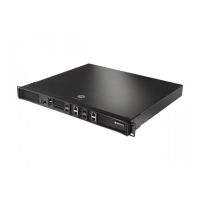17-31
3. Use the network command to map the network pool to interface.
network 192.168.0.0/24
In the above example, 192.168.0.0/24 represents the L3 interface. When executing this
command, no check is performed to verify whether an interface with the specified IP/Netmask exists.
A pool can be created and mapped to a non exisitng L3 interface, hence a verification is not required.
Later (when you add a L3 interface and assign an IP address to it), the DHCP Server gets enabled/
started on the interface. If you have a pool for
192.168.0.0/24, but the L3 interface is
192.168.0.0/16, DHCP wont be enabled on 192.168.0.0/16, as it is different from 192.168.0.0/
24.
4. A network pool without any include range is as good as not having a pool at all. Add an include range
using the
address range CLI command
address range 192.168.0.30 192.168.0.30
5. To work properly, a host pool should have the following 3 items configured:
• client-name ( CLI is
client-name <name> )
• fixed-address ( CLI is
host <ip> )
• hardware-address/client-identifier
CLI for hardware address is
hardware-address <addr>
CLI for client-identifier is client-identifier <id>
If using client-identifier instead of hardware-address, the DHCP client sends the client-
identifier when it requests for IP address.
6. A host pool should have its corresponding network pool configured, otherwise the host pool is
useless. The fixed IP address configured in the host pool must be in the subnet of the corresponding
network pool.
7. Use the global configuration mode
service dhcp to enable/disable the DHCP Server. This
enables/disables the DHCP Server on all interfaces.
8. If you create a pool and map it to interface, it automatically gets enabled, provided DHCP is enabled
at the global level. Use the
no network command to disable DHCP on a per pool/interface basis.
9. To add a newly created pool to the network pool, use one of the following:
• network ( Eg network 192.168.0.0/24 )
• address range ( Eg address range 192.168.0.30 192.168.0.50 )
10. To add a newly created pool to host pool, use one of the following:
• host ( Eg host 192.168.0.1 )
• client-name ( Eg client-name "kaveri" )
• client-identifier ( Eg client-identifier "aabb:ccdd" )
• hardware-address ( Eg hardware-address aa:bb:cc:dd:ee:ff )
11. A pool can be configured as the host pool or network pool, but not both.
12. A host pool can have either
client-identifier or hardware-address configured, but not both.
13. An excluded address range has higher precedence then an included address range. If a range is part
of both an excluded and included address range, it will be excluded.
14. DHCP options are first defined at the global level, using
ip dhcp option <name> <code> <type>.
The value for these options are associated using the
option which is under DHCP pool context.

